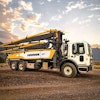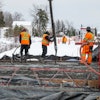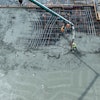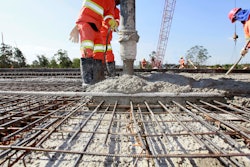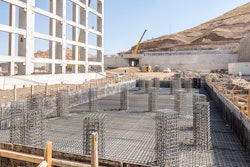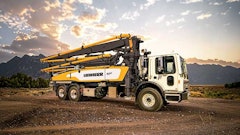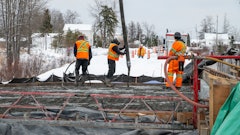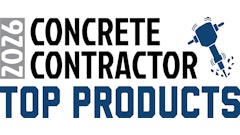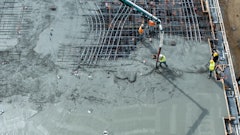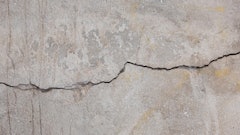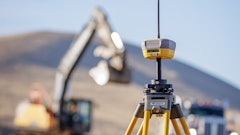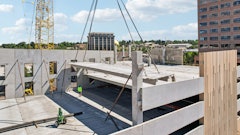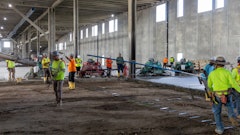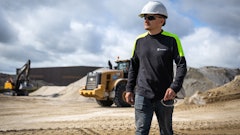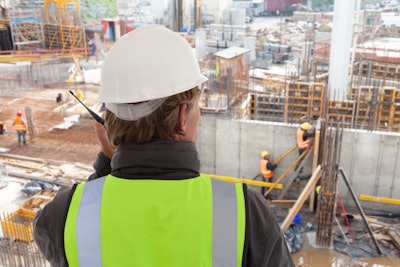
At its core, concrete construction hasn’t changed much. If you excavate deep enough to the core of the work, there isn’t much of a difference between the concrete contractors do today versus what was done back in ancient Roman times. What has changed (and significantly, I might add) are the materials, methods, the science, the technology.
It’s said that concrete construction is a slow industry to adopt new solutions – nothing gets wide-acceptance without its due process and field testing. Yet, the field is changing year over year. Electric equipment and tools help lessen the carbon dioxide footprint of each construction site. Artificial intelligence-powered solutions are providing ways to create the mix design at the plant, control mix in the truck, find efficiencies in scheduling, not to mention a bit of aid in writing an email.
Concrete Contractor connected with a panel of insiders to find out where the industry is headed. Our panel includes: Larry Rowland, Sustainability Market Manager for Heidelberg Materials North America; David Perkins, senior vice president of sustainability and public affairs for Heidelberg Materials North America; Mark Rinehart, vice president of sales and marketing at Cemen Tech; Don Weaver, president of Weaver-Bailey Contractors and the 2025 Board of Directors Chairman of the American Concrete Pavement Association (ACPA); Edward Wessel, president/COO of Hi-Way Paving Inc. and second vice chair of the ACPA; Dirk Tharpe, territory sales manager at Oldcastle APG; Peter Bigwood, general manager at Mecalac North America; Bill Harman, vice president of product management, commercial and general construction at DEWALT; Marianna Kopsida, PhD, industry manager - IMF & Vertical Construction at Trimble; and Jeff Keeling, vice president of sales and marketing at Brokk Inc.
Q. What technological areas do you see the potential for innovation?
 Larry Rowland, Sustainability Market Manager for Heidelberg Materials North AmericaHeidelberg Materials North America
Larry Rowland, Sustainability Market Manager for Heidelberg Materials North AmericaHeidelberg Materials North America
Rinehart: Anything that can give [contractors] more information to make better decisions with an AI and digitizing the jobsite/project more so they can analyze how they can cut costs and reduce labor, is going to always be important.
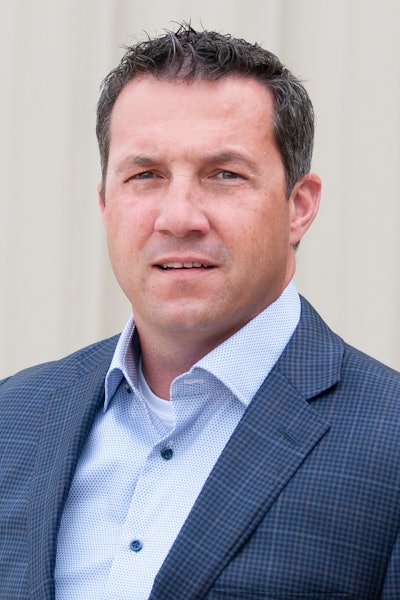 Mark Rinehart, vice president of sales and marketing at Cemen TechCemen Tech
Mark Rinehart, vice president of sales and marketing at Cemen TechCemen Tech
Digitizing the construction process can always help, such as understanding material usage, what their loss is on materials, and factors that they don't think about because they're going 100 miles an hour. Having alerts and solutions that understand situations like having a forgotten piece of equipment out on rent that has been sitting in some guy's yard for 2 weeks. It’s tough to do when you have 100 pieces of equipment or 50 trucks running around.
 Edward Wessel, president/COO of Hi-Way Paving Inc. and second vice chair of the American Concrete Pavement AssociationAmerican Concrete Pavement Association
Edward Wessel, president/COO of Hi-Way Paving Inc. and second vice chair of the American Concrete Pavement AssociationAmerican Concrete Pavement Association
Tharpe: The future of concrete construction can be summed up in these categories: Smart Concrete Technology, Sustainable Construction, and AI-driven advances. Anything is possible. For example, in sustainable construction, the industry as a whole has switched to Type IL Cement, which was a significant shift.
Q. What innovations would you like to see developed in concrete equipment and tools?
 Dirk Tharpe, territory sales manager at Oldcastle APGOldcastle APG
Dirk Tharpe, territory sales manager at Oldcastle APGOldcastle APG
Weaver: GPS leads to stringless work and overall improvements in quality.
Wessel: Manufacturers continue to evolve and improve their equipment to keep up with public demand and to improve the quality of work. I would love to see more automation on repetitive tasks. For example, drilling dowel bars into hardened concrete.
 Bill Harman, vice president of product management, commercial and general construction at DEWALTDEWALT
Bill Harman, vice president of product management, commercial and general construction at DEWALTDEWALT
Kopsida: I would like to see more usage of BIM models and cloud-based connected workflows in the industry, and wider adoption of such connected workflows.
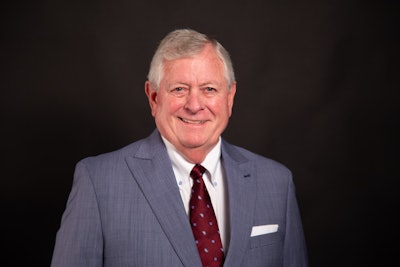 Don Weaver, president of Weaver-Bailey Contractors and the 2025 Board of Directors Chairman of the American Concrete Pavement AssociationAmerican Concrete Pavement Association
Don Weaver, president of Weaver-Bailey Contractors and the 2025 Board of Directors Chairman of the American Concrete Pavement AssociationAmerican Concrete Pavement Association Marianna Kopsida, PhD, industry manager - IMF & Vertical Construction at TrimbleTrimble
Marianna Kopsida, PhD, industry manager - IMF & Vertical Construction at TrimbleTrimble
Q. How will artificial intelligence have the biggest potential to change things for concrete contractors for the better?
Bigwood: AI should continue to evolve and offer up improved methods to provide customer support, including technical documentation, troubleshooting and parts operations; telematics are now becoming ubiquitous, but analytic tools are improving to make the systems more useful; finally, social media, or more specifically, the judicious and strategic use of same will lead to better marketing outcomes for concrete contractors savvy enough to harness its power.
 Peter Bigwood, general manager at Mecalac North AmericaMecalac North America
Peter Bigwood, general manager at Mecalac North AmericaMecalac North America
Tharpe: The future of AI in concrete construction is limitless. We are already seeing leaps in job safety brought on by AI, as well as project management. Speech translation in real time will be a huge help in concrete construction, allowing English-to-Spanish communication, for example.
With enough data, AI algorithms can identify the optimal mix proportions to meet specific project requirements, such as strength, durability, and sustainability. AI will be the key to the continued evolution of construction methodologies. 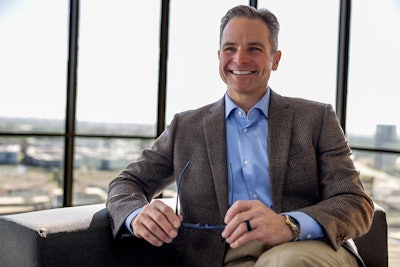 David Perkins, senior vice president of sustainability and public affairs for Heidelberg Materials North AmericaHeidelberg Materials North America
David Perkins, senior vice president of sustainability and public affairs for Heidelberg Materials North AmericaHeidelberg Materials North America
Kopsida: I see immense potential for innovation in the application of Artificial Intelligence (AI) for real-time field optimization and quality control in concrete pours. These solutions could process live data from sensors embedded in concrete and site conditions to provide immediate, actionable insights to field crews, guiding optimal curing practices or identifying potential issues. Furthermore, advanced robotics and autonomous equipment for concrete placement and finishing are poised for significant breakthroughs. These innovations aim to directly address the critical issues of labor scarcity by automating repetitive and physically demanding tasks, significantly enhancing on-site precision, and boosting overall field productivity. 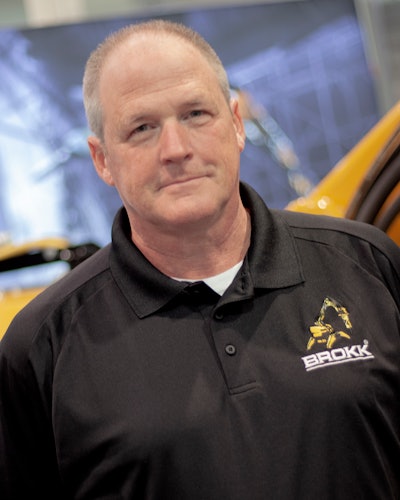 Jeff Keeling, vice president of sales and marketing at Brokk Inc.Brokk Inc.
Jeff Keeling, vice president of sales and marketing at Brokk Inc.Brokk Inc.
Artificial intelligence will have the biggest potential to change things for concrete contractors for the better by revolutionizing field productivity through predictive insights and automated quality assurance. AI has the capability to analyze vast datasets of project variables to offer more precise, real-time guidance to crews. Furthermore, AI-powered tools could provide insights for flatness, levelness, and surface defects, instantly flagging deviations from design specifications. This proactive identification of issues directly reduces costly reworks, ensures higher quality finishes, and significantly boosts overall on-site efficiency by making field operations smarter and more data-driven.
Q. What has caught your interest lately in concrete?
Perkins: The concrete trade has been evolving rapidly, with several trends and innovations catching my attention lately. Some of the key areas that have sparked interest include:
- Advancements in Sustainable Concrete — The push for eco-friendly construction has led to the development of sustainable concrete solutions, such as carbon-neutral concrete and recycled aggregate concrete. These materials help us better meet our customers’ demands and reduce the carbon footprint of construction projects. Contractors are exploring ways to integrate these solutions without compromising on strength and durability.
- Use of AI and Automation — Artificial intelligence and automation are being increasingly adopted in the concrete trade for tasks like mix optimization, quality control, and predictive maintenance. AI-driven tools are improving efficiency and reducing waste in concrete production. This automation is helping contractors address labor shortages and streamline operations.
- Ultra-High-Performance Concrete (UHPC) — UHPC is gaining traction for its exceptional strength, durability, and resistance to environmental factors. It is being used in critical infrastructure projects, such as bridges and high-rise buildings and the long lifespan reduces maintenance costs, making it a cost-effective choice in the long run.
- 3D Printing with Concrete — The use of 3D printing technology in concrete construction is revolutionizing the way structures are designed and built. It allows for faster construction, reduced material waste, and complex designs that were previously difficult to achieve are now possible, unlocking some really creative thinking across the industry.
The concrete trade is undergoing a transformative phase, driven by sustainability, technology, and the need for resilience. These developments are not only improving the quality and efficiency of construction but also unlocking new opportunities. Contractors and industry professionals are actively exploring these innovations to stay ahead in a competitive market.
Keeling: We were excited to work with a demolition contractor on a recent project. Their team decided to take on a concrete removal project for a breakwater in Lake Michigan. They needed to break away 2 ft. of damaged concrete before another team came through and repoured, adding an additional 2 ft. to the original height of the breakwater.
The team before them tried using a mini excavator for the job, but they were only able to break out 20 ft. of concrete a day. With a tight deadline, they weren’t able to work fast enough. So, they reached out a contractor in the area to see if they could get the job done faster. The new team used a Brokk 300, a Darda C12 splitter and a Brokk 500 with a BHB 552 breaker to crush the concrete. In just 9 days, they removed 420 tons of concrete, making the process 7.5 times faster and completing the project with plenty of time to spare.
Tharpe: As a leading dry-mix concrete producer, we must note a growing social media trend — the “dry pour” method. This practice involves pouring dry concrete mix into a form and adding water afterward. It is misleading and unsound from a structural and safety standpoint.
Q. What innovations in equipment do you anticipate in concrete equipment for 2025 and the near future?
Perkins: There are many innovative developments in technology that are now beginning to take hold in the sector, and I anticipate many of these will continue in their deployment this year and beyond. We are seeing an increase in the adoption and use of sensor-enabled equipment, for example. Probes and other equipment are providing real-time data as concrete is being delivered to the worksite, which improves consistency, quality and efficiency while also minimizing waste. This technology is also being leveraged at the construction site with in-situ sensors located directly in concrete as it is placed to provide strength gain, hydration and other critical data. Coupled with the integration of this data into AI-enabled analysis and optimization, mix designs and production processes can be improved and enhanced to provide increased durability, reliability and quality.
On the mobile side, autonomous equipment using advanced sensors, cameras, and artificial intelligence will also continue to see greater adoption and development.
While the adoption of autonomous vehicles in product delivery roles is still many years from implementation, Heidelberg Materials is in the process of deploying autonomous quarry haul trucks at several of our operations across the globe. In the U.S. our first deployment of vehicles at one of our major production sites in Texas, northwest of Fort Worth has been going very well. These are but a small sampling of the many technological advancements that are being made in equipment this year, with acceleration continuing to ramp up in the coming years.
Harman: Electrification in the space will continue to advance, by way of more cordless tools and more powerful battery solutions, driving the conversion from gas to cordless.
Keeling: We’ve seen a push toward electric equipment, which is something our team continues to observe. Virtually all large and midsized heavy equipment manufacturers have introduced an electric option in the last few years. As an electric equipment distributor ourselves, it’s been an interesting process to watch unfold. And it’s created opportunities to add electric equipment that complements Brokk robots. We’ve been able to partner with innovative companies FIRSTGREEN Industries and Ecovolve to add electric loaders and dumpers to our lineup. Rather than offering a single electric product, we’re able to offer electric equipment for multiple steps in the demolition process.
Brokk and FIRSTGREEN are remote-controlled, so we also follow that technology closely as it develops. The technology is such a game changer for safety that it gets a lot of interest.
Rinehart: Concrete printing is super cool and continues to grow and expand. Being able to build a house with reduced labor, reduced materials, and less waste are factors that [the industry] needs to figure out because, again, we can't find people to do these sorts of jobs. Anything that we can use robotically to help, I think, is super cool. I'm excited to see how that industry continues to grow.
Weaver: Iowa State is at the forefront of innovation in concrete materials, and their work amazes and excites us for the future of our industry.
Wessel: We just had ACPA’s mid-year meeting and had a great turnout. Listening to peers who have the same issues that we have and how they work through them is impactful. Our industry has a lot of good people in it. They care where our tax dollars are spent and deliver long-life and sustainable projects that will last.
Kopsida: Seeing contractors creatively leverage existing (Trimble) technology, particularly robotic total stations, beyond their typical uses.
I recently heard a story from a contractor who, faced with a particularly complex residential foundation with numerous angles and varying depths, used their robotic total station not just for initial layout, but to continuously check formwork alignment and pour heights in real-time as the concrete was being placed. This proactive, almost "live" quality control directly impacted their field productivity by catching minor discrepancies immediately, preventing costly reworks that would have required breaking out cured concrete. It was a fantastic example of a contractor pushing the boundaries of existing tools to innovate their on-site process.
Bigwood: With the accent on “light-hearted,” I am continually amazed at how concrete polishing companies can transform older factory and warehouse floors into things of beauty. I know this isn’t exactly the high-tech end of the business, but those guys are magicians!

